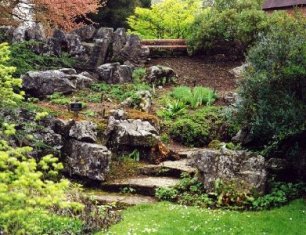I just posted a comment from a reader to another blog entry that inspired me to write a bit more about the subject: edible landscaping. I first considered this concept about 5 years ago and I love it. The idea is to replace the standard landscaping around a house, which is solely decorative, with a landscape that feeds your family and requires little or no additional maintenance and watering.
Consider how much water it takes to grow a lawn, especially somewhere like Las Vegas, NV or Tucson, AZ. Now consider what you get from that lawn: a place to play or lie down (especially with kids), something to mow, something to look at, something to take care of. These benefits, not including the playing, are not worth it for me. I admit that I do love playing on a well maintained field of grass as it brings me back to my childhood in suburban New Jersey; however, that is not enough for me to weather the other aspects of a lawn at this point in my life.
Mowing, fertilizing, edging, weeding, and other maintenance issues all add up to a piece of landscape that hurts my back and the environment much more than it pleases my sense of being a child in New Jersey. After all, there are plenty of parks around that can supply grass for thousand of people at once, why create my own?
Edible landscapes, on the other hand, continue to give gifts of return. I have an herb garden which is beautiful to look at and is more than handy at meal times. I have lavender growing along the South side of my house that smells fantastic, invites in honey bees (something that may be more important than you realize), and can be harvested for the flower and used in oils, ice cream and more.
I have ground cover herbs along the path to my house that look beautiful and the only maintenance they require is trimming when I am ready to eat them. The slope in front of my house has strawberries in an integrated rock garden, and two fig trees stand in front of the entrance to my home.
Last year my wife and I planted some additional fruit trees across from our native grass area to round out our entrance. Yes, we do have some grass, but it is native to our area and therefore does not require additional watering like traditional lawns. It is not nearly as perfect as the lawns you see on tv, but it helps to satisfy my yearning for that place to play.
To make it a little more special, especially because I often don’t take the time to mow it, we mixed native grass with native wildflowers when we planted. The grass, pretty on its own, is even more attractive when the native wildflowers bloom. This also allows me to leave the grass unmowed for almost the entire summer (I literally mow once or twice a year) without it looking ragged.
So plant stuff you can eat. If you don’t want to go that route, consider planting only native plants, including the grass you choose, so that they can survive without you. Sure your grass will brown up when the rains go, but that is part of the way life is designed.
Trying to redesign how nature works so that you can have a pretty piece of green grass to look at is a bit crazy in my mind. I agree with Scott, who posted the original topic of edible landscapes, when he says that landscaping is a great place to start when becoming “Green,” just maybe not in the way the old “Green Thumb” commercials would have suggested.




6 Responses
So, what are the native grasses here in Southern Oregon, Andrew?
Here is a great website for the Oregon native grasses. http://www.oregongrassseed.com/native_grasses.htm We use the red fescue with the wildflower mix.
Do you know if strawbale construction is permissable in New Jersey. I got to your site by searching strawbale New Jersey. I have not been able to determine if it is or not. I have just emailed my various representatives about it.
Thank you.
SB Construction should be fine in New Jersey. There may not be a code for it, but one can usually approve such structures under “alternative” code provisions. Using an engineer is another way to get such plans approved as any liability is shifted away from the building department and placed on the engineer. Good luck.
Hi
Do you know of any grass , herb or cover plants that will do well on sandy hill ground in New Jersey? Deer repellent ?
I don’t know. That is outside of the scope of what I do.